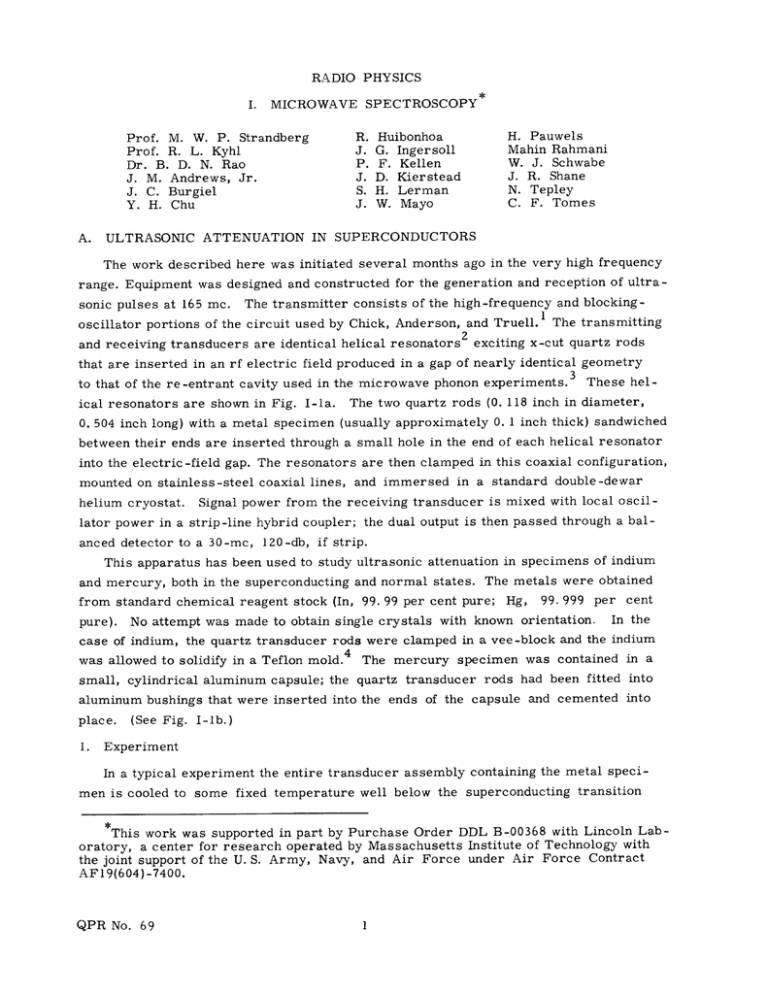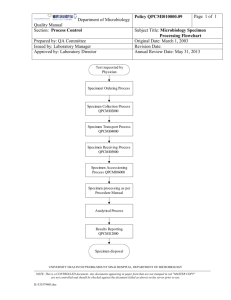RADIO PHYSICS I. MICROWAVE SPECTROSCOPY H. Pauwels
advertisement

RADIO PHYSICS I. MICROWAVE SPECTROSCOPY Prof. M. W. P. Strandberg Prof. R. L. Kyhl Dr. B. D. N. Rao J. M. Andrews, Jr. J. C. Burgiel Y. H. Chu A. R. J. P. J. S. J. Huibonhoa G. Ingersoll F. Kellen D. Kierstead H. Lerman W. Mayo H. Pauwels Mahin Rahmani W. J. Schwabe J. R. Shane N. Tepley C. F. Tomes ULTRASONIC ATTENUATION IN SUPERCONDUCTORS The work described here was initiated several months ago in the very high frequency range. Equipment was designed and constructed for the generation and reception of ultraThe transmitter consists of the high-frequency and blockingoscillator portions of the circuit used by Chick, Anderson, and Truell. The transmitting and receiving transducers are identical helical resonators2 exciting x-cut quartz rods sonic pulses at 165 mc. that are inserted in an rf electric field produced in a gap of nearly identical geometry 3 These helto that of the re-entrant cavity used in the microwave phonon experiments. ical resonators are shown in Fig. I-la. The two quartz rods (0. 118 inch in diameter, 0. 504 inch long) with a metal specimen (usually approximately 0. 1 inch thick) sandwiched between their ends are inserted through a small hole in the end of each helical resonator into the electric-field gap. The resonators are then clamped in this coaxial configuration, mounted on stainless-steel coaxial lines, and immersed in a standard double-dewar helium cryostat. Signal power from the receiving transducer is mixed with local oscillator power in a strip-line hybrid coupler; the dual output is then passed through a balanced detector to a 30-mc, 120-db, if strip. This apparatus has been used to study ultrasonic attenuation in specimens of indium and mercury, both in the superconducting and normal states. The metals were obtained from standard chemical reagent stock (In, 99. 99 per cent pure; Hg, 99. 999 per cent pure). No attempt was made to obtain single crystals with known orientation. In the case of indium, the quartz transducer rods were clamped in a vee-block and the indium was allowed to solidify in a Teflon mold. 4 The mercury specimen was contained in a small, cylindrical aluminum capsule; the quartz transducer rods had been fitted into aluminum bushings that were inserted into the ends of the capsule and cemented into place. 1. (See Fig. I-lb.) Experiment In a typical experiment the entire transducer assembly containing the metal specimen is cooled to some fixed temperature well below the superconducting transition This work was supported in part by Purchase Order DDL B-00368 with Lincoln Laboratory, a center for research operated by Massachusetts Institute of Technology with the joint support of the U. S. Army, Navy, and Air Force under Air Force Contract AF19(604)-7400. QPR No. 69 1I i I I I I l IIIIIIIII 1 111111111111111 IIIIII - (b) Fig. I-1. QPR No. 69 (a) Helical resonators used for the transmitting and receiving transducers. (b) Mercury capsule and the indium mold. The quartz transducer rods are shown protruding from each. (a) (b) Fig. 1-2. (a) Acoustic pulses transmitted through superconducting mercury. al is rf leakage; a 2 , an acoustic pulse that has passed through both quartz rods and the mercury specimen; a 3 , superposition of two acoustic pulses, one having made a double reflection in the first rod, and the other, a double reflection in the second rod. (b) Acoustic pulses transmitted through normal mercury. This is exactly the same situation as in (a), except that a magnetic field H >>Hc(T) has been switched on. QPR No. 69 (I. MICROWAVE SPECTROSCOPY) in the transmitting transducer, The transmitter initiates, temperature. 25 watts, of rf power of approximately fraction of this power (=10 - 3 ) is peak, converted rod, through the specimen, receiving transducer the an rf signal, scope traces. is pulse is The second is reflection in the first rod; the other, is caused At the reconverted into an acoustic rods and the metal specimen. actually a superposition of two acoustic The superposition power is rod. Figure I-2 shows the resulting oscillo- rf leakage. that has passed through both quartz energy of This pulse passes along the of the acoustic reflected. The first pulse effect. and into the second quartz same fraction and the rest is psec in duration. A small 1 into a pulse of acoustic longitudinal polarization by the piezoelectric first quartz and a pulse pulses: a double reflection pulse The third one has made a double in by the fact that the two quartz the second transducer rod. rods are equal in length (within ±.001 in.). An electromagnet specimen, which is surrounds the portion of the cryostat containing capable of providing a variable the metal magnetic field normal to the ultrasonic wave vector and the cylindrical axis of the metal specimen. a magnetic field greater than the critical field of the superconductor on, the metal returns to the normal Figure I-2b is If switched state and the attenuation increases abruptly. shows the same pulse-echo pattern as that shown in Fig. I-2a, except that the magnetic field H >>Hc(T) has been turned on. sonic attenuation is due entirely This change in the ultra- to the effect of the conduction electrons in the metal. The relative attenuation was measured as a function of applied magnetic field for both metals, function, and is plotted in Fig. a result that is and Poulis. 5 1-3. Observe that it is implicit in the aluminum data of David, Data on the total change in attenuation between the a continuous Van der Laan, normal and the superconducting states should probably be taken from the first pulse only. The reason for this is that the acoustic energy that arrives at the receiving transducer at the time indicated by the second pulse, tion of two acoustic paths, it is a superposi- pulses that may well have travelled over slightly different has an unknown phase factor determined by the details of the paths. A specimen of mercury, to obtain reasonably temperature at of this length, approximately 0. 25-in. thick, reliable velocity data. 165 mc and found to be ment with the measurements far, since however, is of Ringo, 1.47 ± .03 Fitzgerald, km/sec, which is and Hurdle. 6 in agree- A specimen more vulnerable to thermal contraction effects. such a long specimen and the quartz QPR No. 69 in order The velocity was measured at room it has not been possible to maintain satisfactory lowered. was prepared acoustic Thus contact between transducer rods as the temperature is T= 1.750K INDIUM A 1st PULSE H, =209 GAUSS I He = 120 GAUSS I 300 200 100 H (GAUSS) (a) 14 12 MERCURY T = 1.90 K 10 8 6 2nd PULSE 4 I He (T) = 325 GAUSS 22 100 300 200 H (GAUSS) (b) Fig. 1-3. QPR No. 69 (a) Relative attenuation of a 165-mc ultrasonic pulse in indium as a function of magnetic field. (b) Relative attenuation of 165-mc ultrasonic pulses in mercury as a function of magnetic field. 5 (I. MICROWAVE 2. Discussion SPECTROSCOPY) An important mechanism for ultrasonic attenuation in metals at sufficiently low temperatures that the electronic mean-free path becomes of the same order of magnitude as the acoustic wavelength (usually below 10 0 K) is the electron-phonon scattering. if we have P Thus, acoustic power incident on a metal specimen of length L, the power P o leaving the specimen will be P = Po exp[-(aelec+ao)L]. (1) Here, aelec is that portion of the attenuation coefficient caused by scattering from the conduction electrons; a is that portion of the attenuation coefficient caused by scat- tering from thermal phonons, lattice defects, grain boundaries, and so forth. ficient a The coef- is temperature-independent in the range of temperatures which we are con- sidering, and therefore will not be discussed further. Using the free-electron model, Pippard has calculated expressions for the electronic contribution to the attenuation coefficient for arbitrary mean-free path. This approach has been well justified by the experimental results of Morse at frequencies between 9 mc and 56 mc. Pippard's result for longitudinal polarization is a a' S 1 1 n (ql) 2 tan ql-tan - (ql) (ql) -Kn, (2) (2) where an the electronic contribution to the attenuation coefficient for the metal in the normal state q 1 the acoustic wave vector the electronic mean-free path. The coefficient a', which is the limiting form of an for long electronic mean-free path, ql >>1, is given by TrNmv w at' (3) 6po where N the number of free electrons per unit volume m the electronic mass v velocity of the free electrons at the Fermi surface w the ultrasonic frequency po the density of the metal specimen u the longitudinal acoustic velocity in the metal specimen. Reasonable estimates based upon the free-electron model, under the assumption of QPR No. 69 MICROWAVE SPECTROSCOPY) (I. yield the following values for a' at 165 mc: one free electron per atom, -1 a' = 4.2 cm-1 Indium -1 Mercury a' = 8. 6 cm1 The Bardeen-Cooper-Schrieffer (BCS) theory of superconductivity has been applied 9 to the calculation of the ultrasonic attenuation in metals in the superconducting state. Their result is a (4) as = 2f[E(T)], n where a = the electronic contribution to the attenuation coefficient for the metal in the s superconducting state f[E] = the Fermi function of the superconducting energy gap E(T) - the temperature -dependent superconducting energy gap. Let us represent the change, in decibels, of the ultrasonic attenuation coefficient between the normal and the superconducting states at any given temperature by D(T). Then D(T) (5) a r4(T)_ n 10 logl0(e) L tanh 2kT where L a the length of the specimen in cm k Boltzmann's constant T the temperature in "K. By using the theoretical curve for E(T) given in BCS, 9 it is possible to determine an from our experiments on indium and mercury. Specimen Purity D(T) T (per cent) (db) 0 ( K) (cm) In 99.99 3.7 (±.5) 1.75 .172 5.0 Hg 99. 999 1.9 .252 4.6 5 (±1.0) L (an)exp (cm - 1) These an, determined experimentally, are of the same order of magnitude as the limiting values a' calculated, by using Eq. 3, for the metals on the basis of the free-electron model. We conclude that for 165 mc the purities of the metals are sufficient to provide electronic mean-free paths at least of the same order of magnitude as the acoustic wavelength. That is, ql > 1. QPR No. 69 (I. MICROWAVE SPECTROSCOPY) As we have already pointed out, the relative attenuation, plotted as a function of magnetic field, does not yield a discontinuity at H c , but rather begins a slow rise at He , well below H c . This might be due to the presence of metallic impurities. Superconducting alloys are sometimes characterized by such a slow transition as a function of magnetic field, but this generally occurs at fields greater than He for the corresponding pure elements. A more cogent explanation is that the metal enters the intermediate state at H e , and then proceeds to the normal state in a continuous manner, the transition reaching completion at Hc(T). This intermediate state is a property of macroscopic superconductors, and depends upon the geometry of the specimen. The same behavior has been observed in the resistivity of macroscopic superconductors as a function of magnetic field. 10 The temperature dependence of H is given by Hc(T) = H (0) [1 c )]. (6) This formula is an approximation, but it is sufficiently accurate for our use. Here, H (0) is the critical magnetic field at absolute zero, and T is the critical temperature at zero magnetic field. Both are properties of the particular superconductor under investigation. We now evaluate Hc(T) for each specimen using their critical constants and the temperature, which was determined from the vapor pressure of the liquid helium. Specimen Hc (0) Tc (gauss) In Hg T H c (T) ( K) ( K) (gauss) 283 3.41 1.75 411 4. 15 1.9 0 0 He (gauss) n exp 209 120 .43 325 237 .27 H e was determined from the graphs of the experimental data (Fig. I-3). The macroscopic theory of superconductivity predicts that the metal will enter the intermediate state at a field H that is such that e H e = c - n. (7) This formula holds for macroscopic pared with a characteristic netizing coefficient length of the specimen bodies whose A = 10 - 5 cm. dimensions are large com- The product 4wrn is the demag- which takes into account the effect of its magnetization on the external magnetic field while in the superconducting state. Obviously, n depends upon the shape of the specimen. We list a few theoretical n values for simple cases: QPR No. 69 (I. MICROWAVE SPECTROSCOPY) n Sphere 1/3 Long cylinder in transverse field 1/2 Long cylinder in parallel field 0 Large disc with its plane normal to field 1 The shapes of our specimens were not controlled accurately, but can be described The indium was formed into a disc, 0. 30 cm in diameter and 0. 172 cm At one edge of the disc, however, there was a sprue almost as large as the disc. approximately. thick. The applied magnetic field was oriented parallel to the plane of the disc. The mercury was contained in a cylinder, 0. 635 cm in diameter and 0. 635 cm long. The quartz rods The applied magnetic field was penetrated 0. 192 cm into the specimen at each end. perpendicular to the axis of the cylinder. The experimental values for n show, indeed, that the shape of the specimen is important in determining the onset of the intermediate state. The author wishes to express his appreciation to E. C. Ingraham for the construction of the helical resonators, the mercury capsule, and portions of the helium cryostat. J. M. Andrews, Jr. References 1. B. Chick, G. Anderson, and R. Truell, J. Acout. Soc. Am. 32, 2. 3. 4. men. 186 (1960). W. W. Macalpine and R. O. Schildknecht, Proc. IRE 47, 2099 (1959). P. H. Carr and M. W. P. Strandberg, J. Phys. Chem. Solids 23, 923 (1962). The author is indebted to Norman Tepley for the fabrication of the indium speci- 6. R. David, H. R. Van der Laan, and N. J. Poulis, Physica 28, 330 (1962). G. R. Ringo, J. W. Fitzgerald, and B. G. Hurdle, Phys. Rev. 72, 87 (1947). 7. A. B. Pippard, Phil. Mag. 46, 1104 (1955). 5. 8. R. W. Morse, Progress in Cryogenics, Vol. 1, edited by K. (Heywood and Company, Ltd., London, 1959), p. 221. 9. 10. Mendelssohn J. Bardeen, L. N. Cooper, and J. R. Schrieffer, Phys. Rev. 108, 1175 (1957). W. J. de Haas, J. Voogd, and J. M. Jonker, Physica 1, 281 (1934). QPR No. 69




